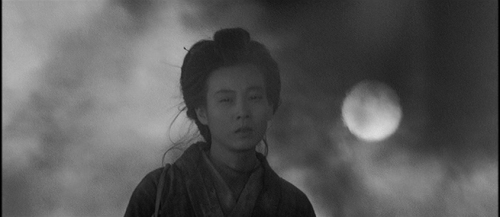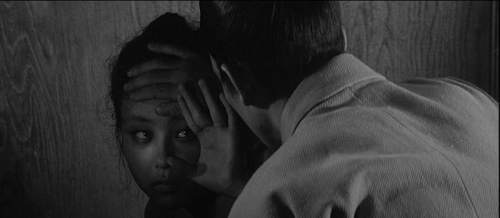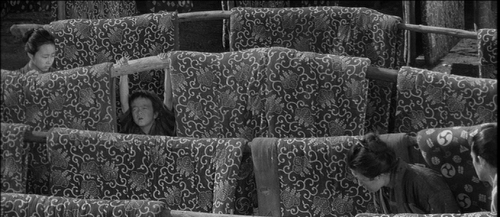
Akahige (Red Beard)(1965)
Directed by Akira Kurosawa
"Cheerful, melancholic schizophrenia" might describe this picture, or perhaps "pulp existential humanism", but not in a cloying I Heart Huckabees way. The story of Yasumoto (Yuzo Kayama), a young, spoiled rich doctor being forced to work at a crowded, under-funded slum clinic run by the superheroic Red Beard (Toshiro Mifune) is the basic frame used by the movie to tell a series of vignettes about people whose methods of interacting with the world are dominated by their poverty and feelings of guilt. Repeatedly, the movie shows lives destroyed or made miserable when someone places the right to property over consideration for others.

This theme is brought to the fore from the beginning when Red Beard asks for Yasumoto's notes and Yasumoto refuses to relinquish them, accusing Red Beard of wanting to steal his ideas. Red Beard replies that medical knowledge belongs to everyone.
It's no surprise Yasumoto wouldn't understand this concept. His assignment at the clinic was quite unexpected--his ambition was to serve as the shogun's personal doctor. The movie takes place in the late Tokugawa period, when shoguns, military generals, were the ruling powers. By Yasumoto's desired position, and the disgust he expresses in being drafted to work at the clinic, we can understand that Yasumoto sees tending to the health of the shogun as a greater honour than tending to the health of the poor. But Yasumoto's young, and Red Beard sees he is essentially good, lacking only better knowledge of human nature. Yasumoto needs to be taken down a few pegs.
We learn that Yasumoto had a fiancée who cheated on him while he was in medical school, and now bears the child of another man. Yasumoto feels only disgust for his former lover, until, in a fever fuelled rant much later in the film, he tells Red Beard about how he was himself nearly seduced by The Mantis, a beautiful, but insane woman isolated in a small house outside the clinic, where only Red Beard and a nurse are permitted to enter.

The Mantis escapes early in the film and traps Yasumoto in his quarters, telling him about her life, how she had been raped by several men, how she felt she couldn't trust men at all, which is why she killed several of her lovers with a hair pin, which she attempts to do to Yasumoto once she has his guard down. Suddenly Yasumoto doesn't feel so superior to his ex-fiancée.
We only see the ex-fiancée once, very briefly, near the end of the film, but Red Beard is filled with more interesting female characters than any other Kurosawa movie I've seen. There's Onaka, who agrees to marry a man, Sahachi, she met one day in a snowstorm, to whom she gives an umbrella.

Although she loves him, he doesn't know that she's already engaged to another man. She doesn't let him meet her parents and manages to keep him ignorant of her other fiancé. The spend two happy years together after being married, but Onaka begins to feel an overwhelming guilt for her happiness, gained at the cost of her broken promise to the other man. When an earthquake strikes while Sahachi is away from home, Onaka uses the excuse to fake her death and return to her former fiancé.

Onaka and Sahachi meet again by chance and now Onaka is carrying the child of the other man on her back. She reveals that she was indeed happier with Sahachi who, despite the anguish he feels at being abandoned, is willing to let Onaka return to her other husband. The guilt drives Onaka to suicide--the story would seem like garish melodrama if not for Kurosawa's expert touch, and his use of the scenario to again illustrate the tragedy of relationships influenced by guilt and territoriality. Onaka's unable to feel happy because of the feeling that her former fiancé "owns" her, and she kills herself because she can't live feeling guilty about ruining her happy life with Sahachi, who would evidently sacrifice his own happiness for her.

My favourite character, though, is a twelve year old girl named Otoyo, an orphan whom Red Beard and Yasumoto rescue from a brothel. She's introduced in an astonishingly stylistic shot, showing her as a ragged black silhouette in the background of one of Kurosawa's distinctive, ingeniously blocked dialogue scenes of five or six characters.

Apparently, Otoyo's story is based on a character, Elena, from Dostoyevsky's The Insulted and Humiliated. This is perhaps a big part of why Otoyo's a fascinating and almost perfectly constructed bundle of guilt and despair.

The brothel madam, although she beats the girl and refers to the girl's persistent shrinking from any touch as "spite", claims an ownership of the girl because she paid for the funeral of the girl's mother, who died on the brothel steps. This, incidentally, means that Red Beard has to, bare-handed, break the arms and legs of twelve hostile yakuza, which he does. How? He's Toshiro fucking Mifune, that's how.


Red Beard takes the feverish Otoyo to the clinic where he assigns her to Yasumoto as his first patient. "Cure her," Red Beard commands.

There's more to Otoyo's illness than a fever, we see quickly, as she pushes away Yasumoto's hand whenever he tries to place it on her forehead or feed her medicine. Of course, Red Beard manages to get Otoyo to swallow a little medicine, but only after she's flung several spoonfuls into his face. Never becoming angry, Red Beard merely smiles with real warmth until Otoyo begins to laugh a little, too, almost against her will as she watches the man with wide, cautious eyes. After she's taken some of the medicine, she buries herself under a blanket, seemingly terrified of what she's done.

Later, Yasumoto attempts to feed her, telling her he wants to help her. Otoyo smashes the bowl and demands, "Do you still want to help me?" which causes Yasumoto to turn away and cry, as he seems to feel utterly helpless. Later, he witnesses Otoyo begging in the streets to acquire just enough ryu to buy him another bowl. When he confronts her, she accidentally drops and breaks the new bowl. He asks her why she had to do this for him. He says he didn't scold her for breaking the other bowl, and he says he apologises if that's the impression she got--and there's this great, perfect moment as Otoyo cries in what seems like absolute despair. It's clearly not the cry of someone who's sorry for the wrong she's committed--though she is--it's the cry of someone who can't escape. She's bound by the concept of ownership of something as simple as a bowl, and a spiral of guilt involved in her inability to make amends or to receive the punishment that seems the natural consequence to her. The brothel madam might have called this reaction "spite", which might be recognised as a symptom of the madam's own suppressed humanity.

Yasumoto contracts Otoyo's fever, and Otoyo seems to grow healthier as she cares for Yasumoto. After Yasumoto recovers, Red Beard assigns Otoyo to work among the clinic's female employees, a contingent of cooks and nurses. We meet another new character, a five or six year old boy named Chobo for whom Otoyo looks the other way while he steals some of the clinic's gruel.
The head cook scolds Otoyo in a tone reminiscent of the brothel madam for aiding the thief and we soon see there is a link. Otoyo and Chobo meet again when Chobo comes to offer Otoyo some candy he's stolen. Otoyo won't take stolen candy--she says she'd sooner beg than steal. Gruel is one thing, but stealing a luxury like candy is evidently beyond the pale for Otoyo's newly emerging sense of morality. Chobo sees it a little differently--begging would be a blow to his pride. In this world, there is power in ownership, and therefore there is more power perceived in stealing than in accepting what is given out of pity.

Listening unseen, the head cook cries, now feeling guilty for wanting to prevent the boy from stealing gruel. She'd have realised sooner if she'd taken the time to think about it--why would a child steal gruel? He's obviously starving.
I'm not exaggerating when I say that Yoshitaka Zushi, the child actor playing Chobo, is the best child actor I've seen on film. I'm not sure how much of it is him or Kurosawa's direction, but there's a scene the kid has with Otoyo where you can clearly see what he's thinking about even as he's saying something that, on the surface, seems to be completely unrelated; he's telling Otoyo she looks beautiful, he wants to remember her this way, and that he and his family are going somewhere where they'll never have to worry about being poor again.

This movie is over three hours long and it feels a bit like the Kurosawa movie to end all Kurosawa movies, though of course he still had several ahead of him, of which I've only so far seen his 80s movies, Kagemusha and Ran, both of which are notably bleaker than the movies I've seen preceding it.
I feel like Kurosawa's movies of the 60s are haunted by The Bad Sleep Well, his version of Hamlet in contemporary, corporate Japan. It's hard to watch that movie without immediately wanting to watch Yojimbo, the film Kurosawa immediately made afterwards. It's as if Kurosawa needed to convince himself that there are good people who triumph in the end. But Yojimbo and its sequel, Sanjuro, don't have quite the resonance of The Bad Sleep Well or the moral ambiguity of High and Low, the noir that comes between Sanjuro and Red Beard. Mifune almost essentially plays the hero character of the Yojimbo films again in Red Beard, and it almost seems as though Kurosawa was trying to inject his super hero into a more complex and dark world. The resulting film is wonderful and brilliant, but I wonder if there's some connexion between Kurosawa's intentions for the film and the fact that it's his last film with Mifune, with whom he became estranged. And I wonder if it relates to Kurosawa's attempted suicide in the early 70s.

No comments:
Post a Comment